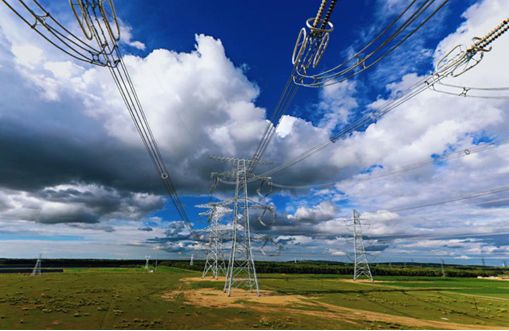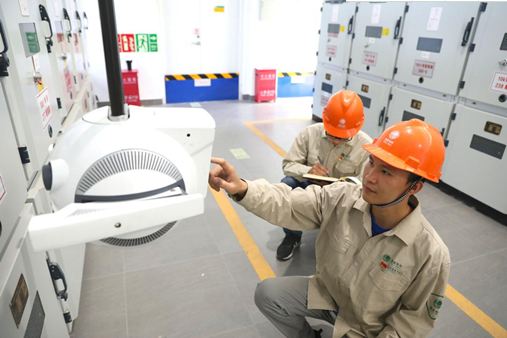Green electricity lights up the Winter Olympics.
2021-01-29

From Zhangjiakou to Beijing, with the comprehensive completion of supporting power grid projects and the commissioning of competition venues, clean wind and solar energy continuously provide sufficient green electricity for the Winter Olympic venues, fulfilling the commitment of 100% green electricity supply for all Olympic venues and supporting facilities.
100% green electricity creates Olympic history
At the starting point of Chang'an Avenue in Beijing, adjacent to the Yongding River and backed by Shijingshan, the new Shougang high-end industrial comprehensive service area is truly the "base camp for ice and snow." Not only is the office of the Beijing 2022 Winter Olympic and Paralympic Games Organizing Committee located here, but also the four winter sports training venues known as the "four ice blocks"—short track speed skating, figure skating, curling, and ice hockey—are situated here.
From the steelmaking plant with sparks flying and molten steel flowing, to the fully functional base camp serving the Winter Olympics, the present and past of the Shougang Park represent a leap between two eras. To welcome the 2008 Beijing Olympics and restore a blue sky to the capital, on June 30, 2005, Shougang's heroic furnace—No. 5 blast furnace—was shut down and dismantled, with groups of Shougang workers spontaneously gathering to bid farewell to the No. 5 blast furnace. Today, the once dilapidated factory area has been rejuvenated, taking on a new historical mission.
On January 30, 2019, the green supply signing ceremony for the venues of the Beijing 2022 Winter Olympic and Paralympic Games was held here, clarifying that all 26 venues in the three major competition areas will use green electricity during the competition period. On the same day, new energy power generation companies such as Huadian Group and Jingneng Group signed green electricity transaction intention agreements with the Winter Olympic venues.

Zhangxiong UHV Zhangbei Station UHV Line
This is a milestone day, marking the first time in Olympic history that all venues will achieve 100% green electricity supply. Juan Antonio Samaranch, the first vice president of the International Olympic Committee and chairman of the Beijing 2022 Winter Olympic Coordination Committee, stated that it is the first time in Olympic history that all Olympic venues will achieve full coverage of green electricity, becoming a new highlight of the Beijing Winter Olympics.
Zhang Jiandong, vice mayor of Beijing and executive vice chairman of the Beijing Winter Olympic Organizing Committee, believes that the use of green electricity in Winter Olympic venues is a concrete measure to implement the concept of green Olympics and fulfill the commitment made during the bidding process. It plays an important role in promoting the development of clean energy in China and serving ecological civilization construction.
Let green electricity be generated and delivered.
Where does green electricity come from, and what journey has it taken?
"A wind on the dam blows from spring to winter." A local saying reflects the harsh natural environment of the Zhangbei area and symbolizes the rich wind energy resources available locally. Currently, the global energy landscape is undergoing profound changes, with an energy revolution characterized by cleanliness, low carbon, and efficiency quietly taking place. On July 29, 2015, the State Council approved the "Development Plan for the Renewable Energy Demonstration Zone in Zhangjiakou City, Hebei Province," agreeing to establish the Zhangjiakou Renewable Energy Demonstration Zone. According to the plan, Zhangjiakou will develop three types of renewable energy projects: a wind power base with a capacity of tens of millions of kilowatts, a large-scale photovoltaic power generation base, and large-capacity solar thermal power generation projects. It is expected that by 2030, the installed capacity of wind power will reach 20 million kilowatts, photovoltaic power will reach 24 million kilowatts, and large-capacity solar thermal power generation will reach 6 million kilowatts.

State Grid Beijing Shijingshan Company uses intelligent robots to inspect Winter Olympic power equipment.
Green electricity must not only be generated but also delivered. According to the "Low Carbon Olympics Smart Grid Planning Scheme," the supporting power grids of the three competition areas in Beijing, Yanqing, and Zhangjiakou, as well as the Zhangbei flexible DC grid experimental demonstration project, jointly create an energy internet innovation demonstration area centered on "smart grid + clean energy." A strong, intelligent, clean, and efficient green power grid continuously delivers green electricity to the Olympic venues, accumulating energy for a low-carbon Winter Olympics.
In addition to the visible green power grid, another invisible green electricity trading network is also continuously playing a role. On December 18, 2020, reporters visited the Hebei North Power Trading Center, where various electricity trading data were rolling on the electronic screen. The center's head said that the end of the year is the time for power generation companies and electricity customers to negotiate pricing. Under the guidance of the four-party cooperation mechanism, the power trading center relies on the power trading platform to sell clean electricity directly to customers through market-oriented transactions, meeting local electricity needs such as electric heating.
In September 2017, the National Development and Reform Commission issued the "Price Policy Opinions on Clean Heating in Northern Regions," encouraging clean heating electricity to actively participate in market-oriented transactions, and stipulating that the transmission and distribution price for heating electricity during off-peak hours will be 50% of the regular transmission and distribution price. In November 2017, under the leadership of the Zhangjiakou municipal government, relevant parties held multiple consultations, and the four-party cooperation mechanism was implemented for the first time on the Hebei North Power Trading Platform, opening the way for market-oriented trading of renewable energy electricity in China. Under this mechanism, the government, power grid companies, power generation companies, and users jointly participate in market-oriented transactions, breaking through the bottleneck of renewable energy consumption and achieving a balance of economic, ecological, and social benefits.
In November 2018, China's first green electricity trading rules—the "Beijing-Tianjin-Hebei Green Electricity Market-Oriented Trading Rules (Trial)" were officially issued, allowing renewable energy power generation companies in the Beijing-Tianjin-Hebei region to conduct market-oriented trading for electricity beyond the guaranteed purchase hours; the green electricity trading between Winter Olympic venues and new energy power generation companies was prioritized.
Market-oriented trading is like an invisible hand that connects wind power companies and electricity customers. On one hand, new energy power generation companies gain certain economic benefits by participating in green electricity trading while fulfilling their social responsibilities and promoting the consumption of new energy; on the other hand, Winter Olympic venues reduce electricity costs through green electricity trading, practicing low-carbon concepts. The power trading center serves as a basic platform for optimizing the allocation of power resources and promoting the consumption of clean energy, providing fair, open, stable, and smooth channels for power generation companies and electricity customers.
On July 1, 2019, the green electricity trading work for the venues of the Beijing Winter Olympics officially started, with the first batch of seven Winter Olympic venues and supporting service facilities using green electricity. The main person in charge of the green electricity trading working group of the Winter Olympic cooperation working group said: "From 2019 to 2020, the Winter Olympic Organizing Committee plans to include all electricity used during the venue construction period, test event period, and Olympic competition period in green electricity trading, with an estimated total trading volume of about 700 million kilowatt-hours."
Green Olympics, green electricity
On the morning of December 10, 2020, reporters entered the 110 kV Haituo Substation located in Xiaohaituo Mountain, Yanqing District, Beijing. The station is built in a staggered structure along the mountain, with photovoltaic panels installed on the roof to achieve green electricity use within the station. Guan Tao, chief engineer of the Yanqing Power Supply Company, said: "This substation is located in the core area of the Winter Olympic venues. We used the excavated rough stones to build the outer wall of the substation, which is both environmentally friendly and aesthetically pleasing."
From planning, construction to implementation, the concept of green hosting of the Olympics is a consistent philosophy of the company. Gu Yi, director of the Planning Department II of the State Grid Development Department, said: "The company is based in Beijing and Zhangjiakou, leveraging their unique resources and location advantages, actively creating an innovative demonstration area for the energy internet centered on 'smart grid + ultra-high voltage grid + clean energy', providing safe, reliable, and clean power guarantee for the Winter Olympics."

State Grid Beijing Electric Power maintains the charging facilities in the underground parking lot of Wukesong Sports Center.
The largest centralized electric vehicle charging station in the Beijing area, built by the State Grid Beijing Electric Power Company, was put into operation on May 15, 2020, in the underground parking lot of Wukesong Sports Center. With 80 60-kilowatt DC charging piles and 120 7-kilowatt AC charging piles, the maximum daily charging service capacity can reach 1,300 vehicles. This year, State Grid Beijing Electric Power fully implements the national "new infrastructure" deployment, adding 1,187 charging piles to the previously planned 1,632 new energy vehicle charging piles, totaling 2,819 charging pile construction projects, covering the urban sub-center of Beijing, venues for the 2022 Beijing Winter Olympics and Paralympics, service areas along the Jingli Expressway, and the Daxing International Airport economic zone, serving the construction of charging facilities and the development of electric vehicles in the capital.
Currently, the company has built 326 charging piles around the venues in the Beijing competition area; invested in the construction of photovoltaic power generation, energy storage systems, and integrated charging demonstration stations in the Yanqing competition area; and has completed 107 charging stations with 720 charging piles along the highways and urban areas around Zhangjiakou, providing convenient charging services for transportation in the Winter Olympic competition area.
Ensuring high air quality in the competition area and its surroundings is a commitment made by the Beijing Winter Olympics to the international community and carries the expectations of local residents. From 2018 to 2020, the company made every effort to promote clean heating in northern regions, implementing "coal-to-electricity" for 8.63 million households, adding 679 million square meters of electric heating area. During the two heating seasons from 2018 to 2020, a total of 24.9 billion kilowatt-hours of heating electricity was completed, and it is expected that 20.7 billion kilowatt-hours of heating electricity will be replaced in the 2020-2021 heating season, with a cumulative replacement of 45.6 billion kilowatt-hours, replacing 25.33 million tons of scattered coal burning, reducing carbon dioxide emissions by 45.49 million tons, sulfur dioxide by 1.37 million tons, nitrogen oxides by 680,000 tons, and dust by 12.4 million tons, making a significant contribution to the battle for blue skies.
Using the Winter Olympics as a medium, green hosting of the Olympics. As the Winter Olympics approaches, various preparations are being advanced vigorously, using green electricity in the most reliable, economical, and efficient way to illuminate the light of the Winter Olympics, allowing the world to see the beautiful, green, and low-carbon China.
Previous Page
Next Page
Previous Page:
Next page:
recommend News
The two-day team-building event of Zhonglian Kechuang has concluded perfectly.




